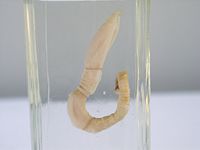Acorn worm
| Enteropneusta | ||||||
|---|---|---|---|---|---|---|
 | ||||||
| Scientific classification | ||||||
| ||||||
|
Harrimaniidae |
Acorn worm is the common name for any of the worm-shaped marine invertebrates comprising the hemichordate class Enteropneusta, characterized by three body parts (protosome or proboscis, mesosome or collar, and metasome or trunk), a covering of cilia, and a solitary, benthic lifestyle. As a member of the phylum Hemichordata, they are closely related to the chordates. While most are small, Balanoglossus gigas of Brazil reaches 1.5 meters (4.5 feet) in length (Mertz 2004).
Overview and description
There are about 70 species of acorn worm in the world, the main species for research being Saccoglossus kowaleski.
All species are infaunal benthos that either may be deposit feeders or suspension feeders.
One genus, Balanoglossus, is also known as the tongue worm.
Anatomy
The Acorn worm's body is cylindrical. The body is made up of three main parts: the acorn-shaped proboscis, a short fleshy collar that lies behind it, and the long trunk, which is the rest of the body. The creature's mouth is located at the collar behind the proboscis. One theory is that this three-part body originates from an early common ancestor of all the deuterostomes, and maybe even from a common bilateral ancestor of both the deuterostomes and protostomes.
The skin is covered with cilia as well as glands that secrete mucus. Some produce a bromide compound that gives them a medicinal smell and might protect them from bacteria and predators.
Acorn worms move by cilia movements and body contractions.
Acorn worms breathe by drawing in oxygenated water through their mouth. The water then flows out the animal's gills which are on its trunk. Thus, the acorn worm breathes about the same way as fish.
Similarities to chordates
Acorn worms are considered more highly specialised and advanced than other similarly shaped worm-like creatures. They have a circulatory system with a heart that also functions as a kidney. Acorn worms have gill-like structures that they use for breathing, similar to the gills of primitive fish. Hence, acorn worms are sometimes said to be a link between classical invertebrates and vertebrates. Some also have a postanal tail which sometimes shows weak signs of segmentation. An interesting trait is that its three-section body plan is no longer present in the vertebrates, except for the anatomy of the frontal neural tube, later developed into a brain which is divided into three main parts. This means some of the original anatomy of the early chordate ancestors is still present even if it is not always visible.
Lifestyle
Acorn worms are rarely seen by humans because of their lifestyle. They live in U-shaped burrows on the sea-bed, from the shoreline down to a depth of 10,000 ft. (3,050 m). The worms lie there with the proboscis sticking out of one opening in the burrow. Acorn worms are generally slow burrowers.
To obtain food, many acorn worms swallow sand or mud that contains organic matter and microorganisms in the manner of earthworms (this is known as deposit feeding). At low tide, they stick out their rear ends at the surface and excrete coils of processed sediments (casts).
Another method that some acorn worms use to obtain food is to collect suspended particles of organic matter and microbes from the water. This is known as suspension feeding.
Reproduction
Acorn worms have separate genders that release eggs and sperm into the water for external fertilization. In some, eggs develop into free-swimming larvae that look very similar to echinoderm larvae (this suggests vertebrates and echinoderms are closely linked phylogenically). The larvae eventually settle down and change into tiny acorn worms on the surface and take on the burrowing lifestyle. Others don't have a larval stage, but develops directly into small juveniles.
ReferencesISBN links support NWE through referral fees
- Mertz, L. A. 2004. Hemichordata. In B. Grzimek, S. F. Craig, D. A. Thoney, N. Schlager, and M. Hutchins. Grzimek's Animal Life Encyclopedia, 2nd edition. Detroit, MI: Thomson/Gale. ISBN 0787657786.
Credits
New World Encyclopedia writers and editors rewrote and completed the Wikipedia article in accordance with New World Encyclopedia standards. This article abides by terms of the Creative Commons CC-by-sa 3.0 License (CC-by-sa), which may be used and disseminated with proper attribution. Credit is due under the terms of this license that can reference both the New World Encyclopedia contributors and the selfless volunteer contributors of the Wikimedia Foundation. To cite this article click here for a list of acceptable citing formats.The history of earlier contributions by wikipedians is accessible to researchers here:
The history of this article since it was imported to New World Encyclopedia:
Note: Some restrictions may apply to use of individual images which are separately licensed.